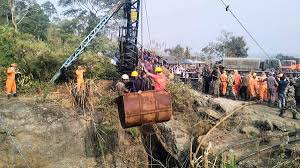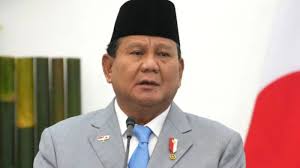Addressing Environmental Challenges and Strengthening Regulations in India

- 28 Jan 2025
In News:
India's recent coal mining tragedy in Dima Hasao, Assam, underscores the nation's ongoing struggle with illegal and hazardous rat-hole mining, despite the National Green Tribunal's 2014 ban. This persistent exploitation, driven by industrial demand for coal, highlights the gap between environmental regulations and their enforcement, revealing a broader issue of balancing economic growth with environmental protection. As India strives to meet ambitious climate goals and sustain economic development, strengthening environmental regulations becomes critical.
Current Environmental Regulations in India
India has established a strong legal framework to protect its environment, grounded in the Indian Constitution. Articles 48A and 51A(g) direct the state and citizens to safeguard the environment, while Article 21 ensures the right to a clean and healthy environment, as interpreted by the Supreme Court. Key pollution control laws include:
- Water (Prevention and Control of Pollution) Act, 1974: Regulates water pollution and establishes pollution control boards at the national and state levels.
- Air (Prevention and Control of Pollution) Act, 1981: Controls air pollution from industrial emissions and vehicles.
- Environment (Protection) Act, 1986: Provides overarching powers for environmental protection.
- Plastic Waste Management Rules, 2016: Regulates plastic waste disposal and bans single-use plastics.
Other significant laws focus on forest and wildlife protection, including the Indian Forest Act, 1927, and the Wildlife (Protection) Act, 1972, along with the National Green Tribunal (NGT) Act, 2010, which ensures quick resolution of environmental disputes.
Key Issues with Enforcement
- Despite these stringent regulations, enforcement remains weak due to institutional limitations. Many industrial units fail to meet environmental standards, with regulatory bodies underfunded and understaffed. For example, pollution control boards in states like Uttar Pradesh and Bihar are plagued by staffing shortages, hampering their ability to monitor pollution effectively.
- Inadequate public participation and insufficient technology adoption further exacerbate these challenges.
- The Environmental Impact Assessment (EIA) process, often bypassed or diluted, leads to development projects being approved without full consideration of their environmental impacts, particularly in ecologically sensitive areas.
Weak Enforcement and Conflict between Development and Conservation
The tension between development and conservation is evident in policies that relax environmental regulations for economic growth. The Forest (Conservation) Amendment Act, 2023, prioritizes infrastructure projects over forest preservation, undermining ecological conservation. Moreover, the rapid urbanization of cities like Gurugram and Faridabad has led to large-scale deforestation and a reduction in natural conservation zones, worsening air and water quality.
Strengthening Environmental Regulations
To address these challenges, India needs to strengthen its environmental regulatory mechanisms:
- Enhance Enforcement: Adequate funding, skilled personnel, and advanced technology, such as AI-based pollution monitoring and drone surveillance, are essential to improve compliance.
- EIA Reforms: The EIA process should be made more transparent and participatory, ensuring that marginalized communities are included in decision-making.
- Promote Clean Energy: Expanding subsidies for renewable energy and encouraging industries to adopt green technologies will help reduce reliance on fossil fuels.
- Circular Economy: Encouraging industries to adopt recycling and upcycling practices can minimize waste and reduce resource extraction.
- Strengthen Local Involvement: Empowering local communities through decentralization under the Forest Rights Act will ensure more inclusive environmental governance.
Conclusion
India’s environmental challenges require a balanced approach, integrating sustainable development with robust environmental protections. Strengthening regulatory enforcement, reforming the EIA process, and fostering community-led conservation are essential to aligning economic growth with environmental sustainability. By addressing these gaps, India can better navigate its path toward achieving both its development goals and climate commitments.
India-Indonesia Relations

- 27 Jan 2025
In News:
The President of Indonesia, visited India as the Chief Guest for the 76th Republic Day in January 2025. This marked the 75th anniversary of diplomatic ties, reaffirming the commitment to deepen cooperation in economic, strategic, cultural, and defense domains.
Historical Foundations
- Ancient Civilizational Links: Trade and cultural exchanges date back to the 2nd century BCE, reflected in the influence of Hinduism and Buddhism on Indonesian society (e.g., Ramayana, Mahabharata, Borobudur, Prambanan).
- Modern Diplomatic Ties:
- Formalized in 1950, with a Treaty of Friendship in 1951.
- Collaborated in the 1955 Bandung Conference and co-founded the Non-Aligned Movement (1961).
- Indonesia’s first President Sukarno was the Guest of Honour at India’s first Republic Day in 1950.
- Cold War and Beyond:
- Relations cooled in the 1960s but revived in the 1980s.
- The 1991 'Look East' Policy and the 2014 'Act East' Policy revitalized ties.
- Strategic Partnership in 2005; upgraded to a Comprehensive Strategic Partnership in 2018.
Key Pillars of Cooperation
- Economic and Trade Relations
- Trade Volume: Reached USD 38.8 billion (2022–23), targeted to increase to USD 50 billion by 2025.
- Key Imports: India imports coal, palm oil, and nickel.
- Investment: Indian investments in Indonesia total USD 1.56 billion in infrastructure, textiles, and energy.
- New Developments:
- MoU on Local Currency Settlement Systems to reduce dependency on USD.
- Focus on resolving trade barriers via forums like WGTI and BMTF.
- Cooperation in critical minerals like nickel and bauxite.
- BPCL to invest USD 121 million in the Nunukan gas block.
- Military Exercises: Garuda Shakti (Army), Samudra Shakti (Navy), and participation in Milan, Komodo, Super Garuda Shield, etc.
- Key Agreements:
- 2018 Defense Cooperation Agreement.
- White Shipping Information Exchange (WSIE).
- Proposal for Bilateral Maritime Dialogue and Cyber Security Dialogue.
- Joint vision on maritime cooperation under SAGAR (Security and Growth for All in the Region).
- BrahMos Deal: Talks underway for Indonesia’s acquisition of BrahMos missiles (~USD 450 million).
- Cultural Diplomacy: Shared heritage of Hindu-Buddhist traditions; India assisting in restoring Prambanan temple.
- Tourism & Connectivity: Direct flights since 2023; India is the second-largest source of tourists to Bali.
- New Initiatives:
- Cultural Exchange Programme (2025–2028).
- India reaffirmed the Kashi Cultural Pathway for heritage restoration and repatriation of artifacts.
- Science, Technology, and Space
- ISRO supports Indonesia’s satellite ambitions; agreement on Biak Tracking Station.
- Renewed MoU on STEM cooperation.
- Areas of collaboration: Quantum tech, high-performance computing, and digital public infrastructure.
- Energy and Health Security
- Collaboration on biofuels under the Global Biofuels Alliance.
- Joint initiatives on mid-day meals and public distribution systems.
- MoUs on digital health, capacity building, and traditional medicine.
Multilateral and Regional Cooperation
- ASEAN & Indo-Pacific: Commitment to ASEAN centrality and cooperation through IPOI, India-Indonesia-Australia Trilateral, and ASEAN-India outlook.
- Global Platforms: Collaboration in BRICS, G20, IORA, and advocacy for the Global South.
- Climate & Disaster Resilience:
- Joint efforts under CDRI.
- Indonesia invited to the International Solar Alliance and Big Cat Alliance.
Key Challenges
- Trade Imbalance: Heavy reliance on limited imports (coal, palm oil); imbalance persists as Indonesia’s trade with China is far greater (~USD 139 billion).
- Bureaucratic & Regulatory Barriers: Slow progress on infrastructure and investment due to permit and regulatory issues.
- Geopolitical Pressures: Indo-Pacific instability and China's expanding influence pose strategic challenges.
- Logistical Constraints: Inadequate connectivity infrastructure hinders deeper integration.
Way Forward
- Trade Diversification: Include sectors like tech, agriculture, and green energy.
- Defense Deepening: Expand joint exercises, maritime patrols, and intelligence-sharing.
- Enhance Connectivity: Boost air, sea, and digital linkages for trade and tourism.
- Green Collaboration: Advance renewable energy and sustainable mining ventures.
- Cultural & Educational Engagement: Promote student exchanges, scholarships (e.g., ITEC), and diaspora involvement.
Conclusion
India and Indonesia share deep-rooted civilizational links and are strategically aligned in the Indo-Pacific. Their evolving Comprehensive Strategic Partnership encompasses trade, defense, technology, and cultural diplomacy. Strengthening this partnership will not only boost bilateral growth but also ensure a stable, multipolar, and cooperative regional order.
India-Sri Lanka Diplomatic Engagement

- 22 Dec 2024
In News:
The recent visit of Sri Lankan President Anura Kumara Dissanayake (AKD) to India marked a significant moment in bilateral relations, as it was his first foreign trip since assuming office. The visit underscored key diplomatic exchanges and collaborations between the two countries, showcasing both areas of agreement and divergence.
Key Takeaways from AKD's Visit
Assurance on Anti-India Activities: One of the primary concerns for India was the use of Sri Lankan territory for activities detrimental to its security, particularly the presence of Chinese “research vessels” at Sri Lankan ports. President AKD assured Prime Minister Narendra Modi that Sri Lanka would not allow its territory to be used in ways that threaten India’s interests. This assurance is crucial, as it signals Sri Lanka's stance on maintaining regional stability, despite AKD’s perceived pro-China inclinations.
Tamil Minority Issue: Divergent Views: A notable divergence in their discussions was the issue of the Tamil minority in Sri Lanka. India has long advocated for the full implementation of the 13th Amendment to Sri Lanka’s Constitution, which would grant greater autonomy to the Tamil minority. However, AKD resisted this, reaffirming his opposition to the amendment’s full implementation. While India emphasized the importance of reconciliation and holding provincial elections, AKD focused on unity, sustainable development, and social protection, sidestepping any definitive commitments on the Tamil issue.
Sri Lanka's Assertive Diplomatic Posture: AKD’s strong parliamentary mandate has allowed him to adopt a more assertive diplomatic stance. This is evident not only in his handling of the Tamil issue but also in his approach to dealing with major powers like India and China. His administration appears to be prioritizing a more independent foreign policy, signaling a shift from previous administrations.
Bilateral Cooperation and Development Initiatives
The visit saw significant agreements on bilateral cooperation, particularly in development and connectivity. Both nations acknowledged the positive impact of India’s assistance in Sri Lanka’s socio-economic growth. Key projects discussed include:
- Indian Housing Project: Phases III and IV.
- Hybrid Renewable Energy Projects across three islands.
- High-Impact Community Development Projects.
- Digital collaborations, such as the implementation of Aadhaar and UPI systems in Sri Lanka.
Additionally, discussions focused on enhancing energy cooperation, including the supply of LNG, development of offshore wind power in the Palk Strait, and the high-capacity power grid interconnection. The resumption of passenger ferry services between key Indian and Sri Lankan ports was also a priority.
Defence and Security Cooperation
The two leaders agreed to explore a Defence Cooperation Framework and intensify collaboration on maritime surveillance, cyber security, and counter-terrorism. This aligns with India’s strategic interests in the region, as it seeks to ensure stability in the Indian Ocean and strengthen its defense ties with Sri Lanka.
Strategic Continuity Amid Leadership Change
Despite a change in leadership, the core strategic interests between India and Sri Lanka remain aligned. India views Sri Lanka’s stability as crucial to regional security, and both countries are focused on a mutually beneficial partnership. AKD’s emphasis on economic recovery and tackling corruption within Sri Lanka, as seen in his actions against political figures like Speaker Asoka Ranwala, further signals his determination to build a strong foundation for his government’s future.
Conclusion
President AKD’s visit highlighted the evolving dynamics of Sri Lanka’s foreign policy, marked by a more confident and independent approach in engaging with India. While challenges remain, especially regarding the Tamil issue, both countries have reaffirmed their commitment to deepening bilateral ties, with a focus on development, connectivity, and strategic cooperation.
